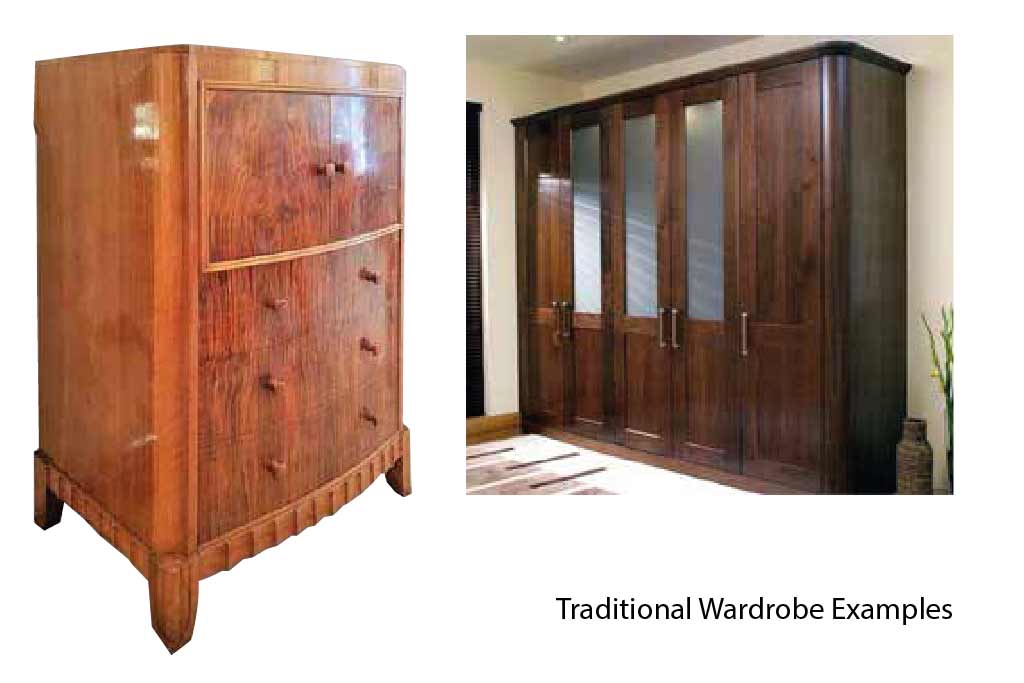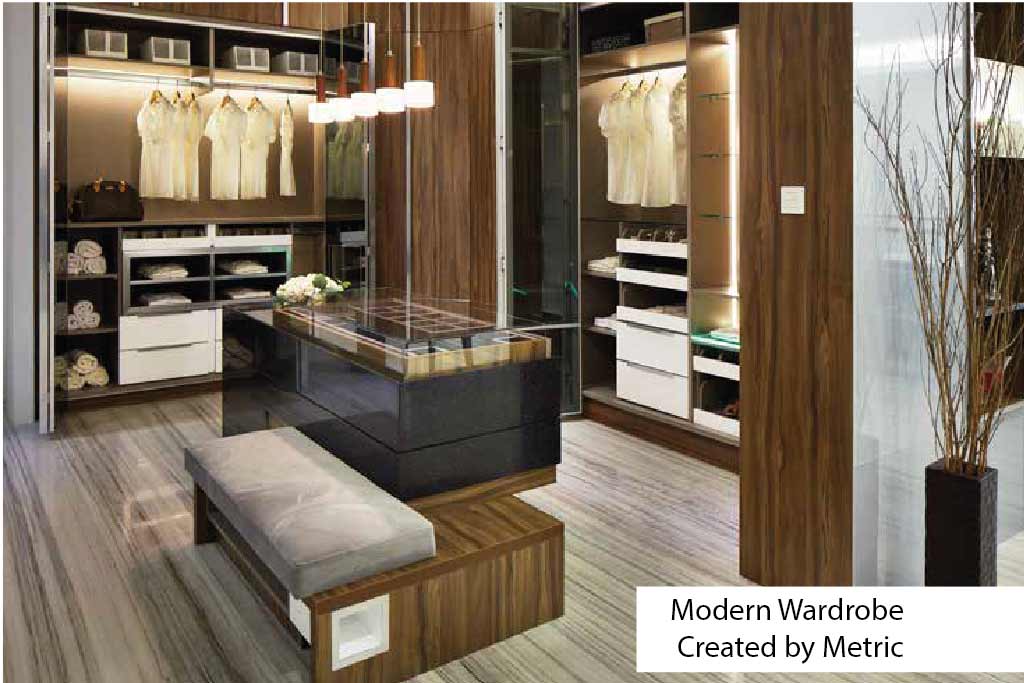Jl. Arteri Pondok Indah 10-10A, Kebayoran Lama, Jakarta Selatan
- P.+62217291520
- P.+62217293308
- P.Contact@metric.id
Storage Ideas Tracing down the history of wardrobe and its design development
Story by Dian Arthen (ID Magazine) & Metric
Wardrobe and closet are two words used interchangeably to describe a medium to store clothes. These two terms however have different meanings in the dictionary, a closet is described as an architectural feature, or a designated space inside a house, whereas a wardrobe is a piece of furniture. Perhaps the main reason why wardrobe and closet now basically describe the same thing is that the modern design has combined these two into one, today’s houses are more likely to have built-in wardrobes along with other shelves located in a specific area that keep not only clothes but also other fashion items such as bags, wallets, and jewelry.
The history of wardrobe can be traced back to the 17th century in the United States. Back then, wardrobes were made in the form of a hanging cupboard made from oak with heavy carvings on its doors. They were huge and the Americans exported them to England and lasted for a hundred years. Then the use of oak for wardrobe gradually decreased and in came the American walnut that became the most sought after material to build a wardrobe.

Around the same time, clothes presses were also on-trend, with drawers and sliding trays. In the 18th century, Tallboy incorporates a chest of drawers and a wardrobe on top with the lower section is usually wider than the upper was on-trend. Tallboy was mostly made from mahogany and the size was measured using the eight small men method, meaning that a Tallboy needs to be able to fit eight small men into it.
By the 19th century, the mass production of furniture was growing and the economy was getting better, people were able to afford more clothes and it led to a modern form of the wardrobe with a hanging cupboard at each side, a clothes-press in the upper part and drawers in the bottom. The most common materials used were mahogany, satinwood, and other previously scarce woods that started to be obtainable. The biggest innovation in the wardrobe was the function of central doors that previously were used to only enclose the upper part, which had been stretched down to the floor, covering the drawers as well as the sliding shelves and featured mirrors on the exterior.
In Indonesia, it wasn’t clear when exactly the wardrobe trend first entered the country. One of the most established furniture makers in Indonesia, Metric founded in 1994, started to branch out to wardrobe in 2001. Back then, wardrobes’ function was only for storing clothes, they tended to be bulky and made of solid woods.
By 2001, Metric came up with wardrobe products made of MDF material and HPL as a complement to their kitchen products. Metric received a positive response from their customers and they decided to add wardrobe as one of their core products. Metric prides itself as a company that understands the customer’s needs and is able to incorporate the furniture design with the customer’s room ambiance.

One fine example is the way Metric builds a built-in wardrobe that is tailored to each room, making it part of the room instead of being seen as a piece of separate furniture. By always offering the latest design trends coming from European countries to their customers, Metric customers are mostly people who are into modern and minimalistic style, they most often ask for a wardrobe that is modern yet simple with great lighting and in a neutral color palette.
The Metric representative further told us that the main challenges in designing a wardrobe are shelves positioning, placement, and designing each of the compartments to be well organized and efficient. If today’s trend is all about a minimalistic approach, in the future the company predicts that people will lean toward rustic and industrialized design, having a wardrobe that features the latest technology yet is environmentally conscious by creating an efficient lighting system.
Story by Dian Arthen (ID Magazine) & Metric
Wardrobe and closet are two words used interchangeably to describe a medium to store clothes. These two terms however have different meanings in the dictionary, a closet is described as an architectural feature, or a designated space inside a house, whereas a wardrobe is a piece of furniture. Perhaps the main reason why wardrobe and closet now basically describe the same thing is that the modern design has combined these two into one, today’s houses are more likely to have built-in wardrobes along with other shelves located in a specific area that keep not only clothes but also other fashion items such as bags, wallets, and jewelry.
The history of wardrobe can be traced back to the 17th century in the United States. Back then, wardrobes were made in the form of a hanging cupboard made from oak with heavy carvings on its doors. They were huge and the Americans exported them to England and lasted for a hundred years. Then the use of oak for wardrobe gradually decreased and in came the American walnut that became the most sought after material to build a wardrobe.

Around the same time, clothes presses were also on-trend, with drawers and sliding trays. In the 18th century, Tallboy incorporates a chest of drawers and a wardrobe on top with the lower section is usually wider than the upper was on-trend. Tallboy was mostly made from mahogany and the size was measured using the eight small men method, meaning that a Tallboy needs to be able to fit eight small men into it.
By the 19th century, the mass production of furniture was growing and the economy was getting better, people were able to afford more clothes and it led to a modern form of the wardrobe with a hanging cupboard at each side, a clothes-press in the upper part and drawers in the bottom. The most common materials used were mahogany, satinwood, and other previously scarce woods that started to be obtainable. The biggest innovation in the wardrobe was the function of central doors that previously were used to only enclose the upper part, which had been stretched down to the floor, covering the drawers as well as the sliding shelves and featured mirrors on the exterior.
In Indonesia, it wasn’t clear when exactly the wardrobe trend first entered the country. One of the most established furniture makers in Indonesia, Metric founded in 1994, started to branch out to wardrobe in 2001. Back then, wardrobes’ function was only for storing clothes, they tended to be bulky and made of solid woods.
By 2001, Metric came up with wardrobe products made of MDF material and HPL as a complement to their kitchen products. Metric received a positive response from their customers and they decided to add wardrobe as one of their core products. Metric prides itself as a company that understands the customer’s needs and is able to incorporate the furniture design with the customer’s room ambiance.

One fine example is the way Metric builds a built-in wardrobe that is tailored to each room, making it part of the room instead of being seen as a piece of separate furniture. By always offering the latest design trends coming from European countries to their customers, Metric customers are mostly people who are into modern and minimalistic style, they most often ask for a wardrobe that is modern yet simple with great lighting and in a neutral color palette.
The Metric representative further told us that the main challenges in designing a wardrobe are shelves positioning, placement, and designing each of the compartments to be well organized and efficient. If today’s trend is all about a minimalistic approach, in the future the company predicts that people will lean toward rustic and industrialized design, having a wardrobe that features the latest technology yet is environmentally conscious by creating an efficient lighting system.